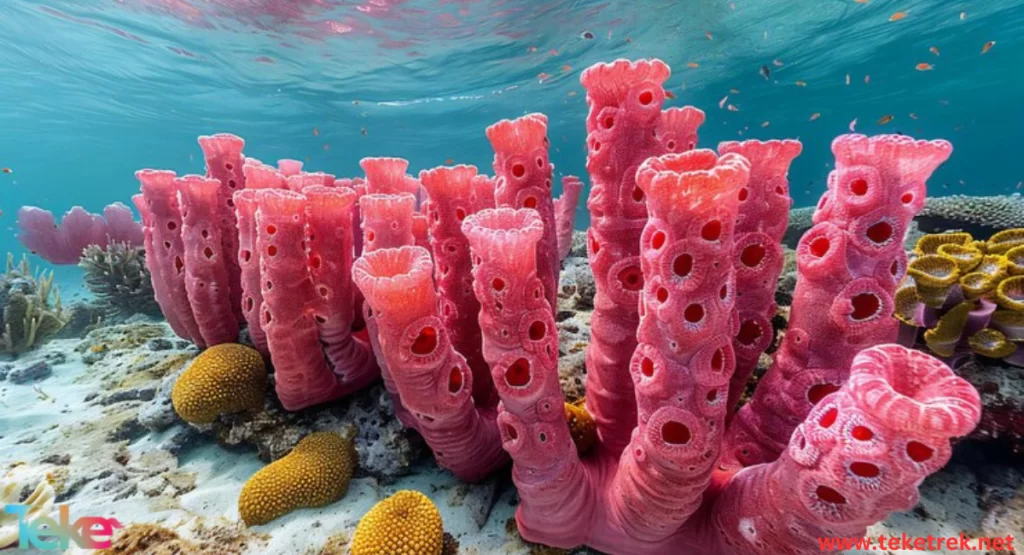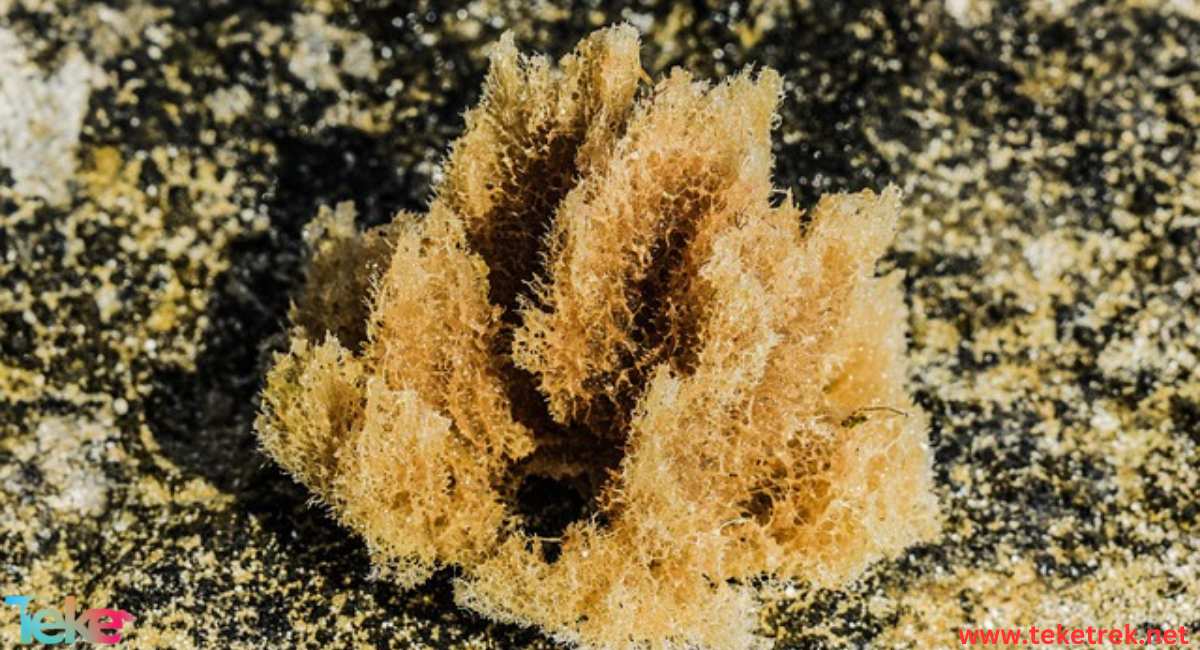Sponges provide many benefits to humans, and are distinguished by their shapes, colors, and multiple methods of reproduction.
Below, on the teketrek website, we will review a detailed explanation of it. We will present its definition, types, how to reproduce it, and enumerate its most prominent benefits.
About sponges
Sponges are primitive aquatic multicellular animals, known as the Porifera phylum in classification of animals, dating back to the Precambrian period.
- It contains about 5,000 species, most of which are marine, but about 150 of them have adapted to live in fresh water.
- You find them attached to the surface in tidal areas and reach depths that may exceed 8500 m.
- In addition, adult sponges lack a nervous and muscular system, so they do not show clear movements of various parts of the body.
- Their shapes, colors, and sizes also vary. You may find some spherical, others branched, and some expanding on the rocks. Its dimensions range from two millimeters to two metres.
- Furthermore, most of them have bright colors due to the pigments found in their dermis cells, including: red, yellow, green, orange, and purple.
- It is worth noting that some of these species are interesting to look at, for example: the genus Euplectella, which lives in the deep depths of the Pacific Ocean. It has the shape of a trumpet, embedded in clay, and is 50 cm long.

Sponge habitats
Sponges are found in various parts of the world. They are able to adapt to various environments. About 98% of sponges live in the sea, while members of the Spongillidae family live in fresh water.
Types of sponges
Sponges are divided into 3 groups, What are 3 types of sponge?
- Glass Sponges, scientifically (Hexactinellida), have a skeleton composed of fragile silica spicules, similar to glass.
- Demo Sponges, scientifically speaking (Demospongiae), are vibrantly colored, grow to become the largest species, and represent 90% of sponges as a whole.
- Calcareous Sponges have spicules made of calcium carbonate and are the smallest species.
Characteristics of sponges
The body of sponges is supported by a structure consisting of fine siliceous or calcareous spicules, in addition to soft, tough protein fibers called spongin fibres. It is also characterized by the fact that its body is composed of two cell layers, where:
- The outer epithelium is simple and consists of cells called pinacocytes.
- While the inner layer is equipped with collar-like cytoplasmic elongations surrounding a flagellum that produces a water current inside the animal’s body, they are called choanocytes or collar cells.
- The space between them contains a mesoglea that includes skeletal elements secreted by special cells called acanthogenesis cells, several types of primary amoeboid cells (archeocytes) that play a major role in feeding sponges, and collencytes.
- It is also characterized by the fact that its body is perforated with several holes called ostia, through which water carrying food passes into the animal’s stomach. Then it travels through a network of radial canals surrounded by ringed cells, opening into the cavity of the sponge through the apopyles, and finally exits through the exhalation orifice, osculum.
- Sometimes the channels and cavities become complex in the organism’s body, and the inspiratory and expiratory holes may connect, as there are 3 patterns:
Ascon type
As is the case in simple sponges such as the genus Leucosolenia, where the shape of the animal is tubular and its wall is thin, its cavity is occupied by a central cavity lined with encircled cells, containing only one expiratory orifice located at the top of the animal.
Sycon type
It is derived from the ascus, as it has the same shape and has only one expiratory orifice, while the wall is thicker and more complex, and the central cavity is surrounded by flat epithelial cells instead of the ringed ones that are located only in the radial tubules.
leucon type
It includes most of the large sponges, which contain a large number of expiratory orifices. It also forms oval or circular chambers surrounded by surrounded cells called flagellated chambers, as is the case in Euspongia.
Lifestyle of sponges
- The sponge’s activities are related to the water currents that pass through its body. It pumps out large quantities, which makes the annular cells capture food in a large way, and then digestion occurs within the cells, where the annular cells pass the food to the primary. This process is called filtration.
- Sponges do not have a respiratory system, as gaseous exchange occurs by permeation through the cell walls, while emptying occurs in pulsatile vacuoles within the primary and circumscribed cells.
- Furthermore, sensation is transmitted from one cell to another through materials that travel with the water current.


How do sponges reproduce?
Sponges are characterized by a variety of methods of reproduction, whether sexual or asexual:
Sexual reproduction
- Most animals are dioecious, and the gametes are derived from amoeboid cells in the gelatinous layer. The cell then divides to produce sperm and eggs.
- After that, fertilization occurs through the sperm entering the organism’s body through the inhaled openings. Then the sperm enters a ring cell, loses its collar and flagella, and becomes a sperm carrier. It enters the gelatinous layer until it finds the egg cell, injects it with the sperm, and it recedes. Until the cell completes its mature divisions, the male nucleus then unites with the female nucleus to produce a fertilized egg.
Regeneration and asexual reproduction
Large sponges can regenerate, so if you cut them into pieces, each piece grows and forms a new organism. They can also reproduce asexually in two ways:
- External budding: This is known in the sponges of Altetia, where small buds are formed on the surface of the body, consisting of several undifferentiated cells that separate, each of which is fixed on a substrate and differentiates to form new sponges.
- Pearls: As is the case in freshwater sponges, where pearls are formed in the fall, each pearl consists of several cells.
- Laia primary surrounded by a cover of small spines. After that, the tissue decomposes in the winter, and the pearls are released on the bottom to produce new sponges in the spring.
Benefits of sponges
Sponges have several benefits for humans, as follows:
- It is considered a natural resource because it can grow and regenerate after being harvested, which makes it a source of income.
- Natural sponges are free of toxins and do not cause allergies, while synthetic sponges are treated with toxic substances.
- Sea sponges can naturally exfoliate the body and remove dead skin.
- It is also highly absorbent, forms foam when used for cleaning, and is suitable for sensitive skin.
FAQ
- What kind of animal is a sponge?
Sponges are primitive, multicellular aquatic animals.
- What is special about sponges?
Its body is supported by a structure composed of fine siliceous or calcareous spicules, with soft, tough protein fibers called spongin fibers. Its body is also composed of two layers of cells.
In short, sponges are primitive organisms with a simple structure that inhabit marine areas. They have three main types. They possess a set of characteristics such as their size, colors, and shapes like branched trees. They reproduce sexually or asexually.






